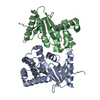+Search query
-Structure paper
| Title | Structural mimicry of UM171 and neomorphic cancer mutants co-opts E3 ligase KBTBD4 for HDAC1/2 recruitment. |
|---|---|
| Journal, issue, pages | Nat Commun, Vol. 16, Issue 1, Page 3144, Year 2025 |
| Publish date | Apr 2, 2025 |
 Authors Authors | Zhuoyao Chen / Gamma Chi / Timea Balo / Xiangrong Chen / Beatriz Ralsi Montes / Steven C Clifford / Vincenzo D'Angiolella / Timea Szabo / Arpad Kiss / Tibor Novak / András Herner / András Kotschy / Alex N Bullock /   |
| PubMed Abstract | Neomorphic mutations and drugs can elicit unanticipated effects that require mechanistic understanding to inform clinical practice. Recurrent indel mutations in the Kelch domain of the KBTBD4 E3 ...Neomorphic mutations and drugs can elicit unanticipated effects that require mechanistic understanding to inform clinical practice. Recurrent indel mutations in the Kelch domain of the KBTBD4 E3 ligase rewire epigenetic programs for stemness in medulloblastoma by recruiting LSD1-CoREST-HDAC1/2 complexes as neo-substrates for ubiquitination and degradation. UM171, an investigational drug for haematopoietic stem cell transplantation, was found to degrade LSD1-CoREST-HDAC1/2 complexes in a wild-type KBTBD4-dependent manner, suggesting a potential common mode of action. Here, we identify that these neomorphic interactions are mediated by the HDAC deacetylase domain. Cryo-EM studies of both wild-type and mutant KBTBD4 capture 2:1 and 2:2 KBTBD4-HDAC2 complexes, as well as a 2:1:1 KBTBD4-HDAC2-CoREST1 complex, at resolutions spanning 2.7 to 3.3 Å. The mutant and drug-induced complexes adopt similar structural assemblies requiring both Kelch domains in the KBTBD4 dimer for each HDAC2 interaction. UM171 is identified as a bona fide molecular glue binding across the ternary interface. Most strikingly, the indel mutation reshapes the same surface of KBTBD4 providing an example of a natural mimic of a molecular glue. Together, the structures provide mechanistic understanding of neomorphic KBTBD4, while structure-activity relationship (SAR) analysis of UM171 reveals analog S234984 as a more potent molecular glue for future studies. |
 External links External links |  Nat Commun / Nat Commun /  PubMed:40175372 / PubMed:40175372 /  PubMed Central PubMed Central |
| Methods | EM (single particle) |
| Resolution | 2.71 - 3.3 Å |
| Structure data | EMDB-51335, PDB-9ggl: EMDB-51336: Cryo-EM map of KBTBD4 WT-HDAC2-CoREST1 2:1:1 complex mediated by molecular glue UM171 EMDB-51337, PDB-9ggm: EMDB-51338, PDB-9ggn: |
| Chemicals |  ChemComp-ZN:  PDB-1acv: |
| Source |
|
 Keywords Keywords | LIGASE / E3 ligase / deacetylase / ubiquitylation / transcription / molecular glue / complex / cancer mutation / protein complex |
 Movie
Movie Controller
Controller Structure viewers
Structure viewers About Yorodumi Papers
About Yorodumi Papers











 homo sapiens (human)
homo sapiens (human)